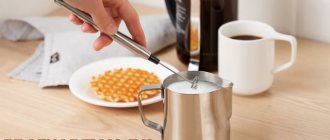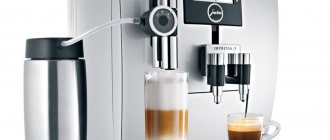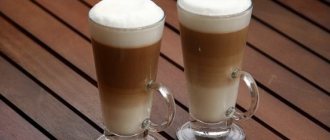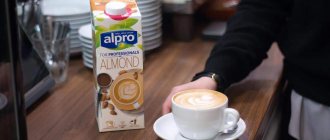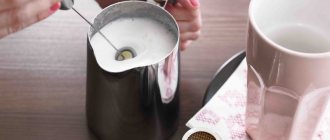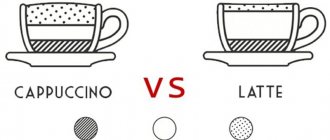August 9, 2013 Equipment and accessories
A pitcher is one of the barista’s tools, a container for frothing milk for cappuccino or latte. He is also the milkman or jug (jag). To prepare some coffee drinks (cappuccino and latte), milk foam is added to freshly prepared espresso.
The optimal utensil for preparing milk foam is a pitcher - a special stainless steel jug. Metal is predominantly used for their manufacture due to its good thermal conductivity, although there are also options made of aluminum, ceramics, glass and plastic, but they are not considered reliable.
Varieties of milkweed
A pitcher (a special glass or bowl) helps froth milk to make a latte or cappuccino. This accessory is designed for an experienced barista, which he cannot do without. It creates comfortable and harmonious conditions that contribute to the high-quality preparation of coffee drinks.
Pitchers come in a variety of sizes: from the smallest (from 125 ml) to 1 - 1.5 l. They are also distinguished by the material from which they are made.
Milkmen are:
- glass;
- porcelain;
- Teflon;
- metal.
The shapes and sizes of noses also matter. Using the spout, a thin stream is formed, which introduces fine milk into the prepared coffee (for latte art).
How to choose the right pitcher
Product material
Attention should be paid to the material from which the container is made. Pitchers are mainly made from stainless steel. It is also considered the best material for this type of cookware.
What is the advantage
In the store you can find pitchers made of metal or other various materials. The metal version is also good to use and can last a long time. But dishes made of ceramics, glass or plastic are considered less reliable.
Stainless steel also conducts heat well, which has a positive effect on the resulting foam, since during its production it is important to maintain temperature control.
External factors influence a metal pitcher much less than any other pitcher, so there is less worry about its condition.
If you plan to purchase a pitcher only for personal use, then you can consider models with Teflon coating, which is currently beginning to gain popularity. This material is easier to wash because milk practically does not settle on it. But due to the fact that Teflon wears off quite quickly, its service life is significantly reduced.
Pen
In most cases, pitchers have a handle that is shaped to be comfortable to hold while frothing milk. However, do not be surprised if it is completely absent. Currently, they produce pitchers with thermally insulating linings that allow you to hold the container in any convenient position.
Volume
The volume of the container ranges from 100 milliliters to 2 liters. The most popular are: 350 ml, 500-600 milliliters and 1 liter.
What pitcher do you use?
Metal
Ceramic
Why are there so many pitcher volume options?
It's quite simple. We must not forget that milk increases significantly in volume after whipping, so it is worth taking this into account when purchasing a pitcher of a certain size.
First, it is determined how much milk is needed for preparation, i.e. How many servings of coffee are you planning to prepare at one time? To make one cappuccino, there is simply no need for a lot of foam. But beginners who have had little practice in making foam before need to know a few subtleties.
We must remember that any pitcher is filled halfway with milk. If there is very little of it, then difficulties may arise with preparation due to the fact that it is easier to overheat it, which will render the resulting foam unusable. But many people like to use milk “with reserve”; naturally, this will require a large container.
And with a big pitcher there can be problems. At a minimum, whipping a small amount of milk in a large container is quite inconvenient, because... the steam tap may simply not reach the liquid level.
How to froth milk
There are no strict rules for preparing coffee drinks. Some people prefer to prepare the espresso first and then prepare the milk. Others froth milk and then brew coffee.
Baristas do everything at the same time: milk is frothed while coffee is extracted. At the beginning of the foaming process, the steam valve opens for a few seconds and the condensate drains. If you do not carry out this procedure, it can spoil the taste of the coffee drink, and whipping will be delayed. Then milk is poured into the pitcher, maintaining a certain level (not higher than the base of the milk jug's spout).
The steam tap is then immersed in the pitcher. In this case, its nozzles are installed 1-1.5 cm below the milk level. Next, the preparation is divided into two phases.
I f. – foaming. Its duration is 5-15 seconds. Open the steam tap with quick movements. At the same time, the milk warms up to 37 degrees and is filled with small air bubbles. They help increase the volume of liquid by 2 times.
Rules for selecting a pitcher
You need to pay attention to the following points.
Pen
There are different models. Some are released without a handle at all. This is extremely inconvenient.
You need to choose either a pitcher with a classic handle, or modern models equipped with thermal linings that protect against high temperatures.
Material of manufacture
There are 3 options available in the market.
- Metal. The most common models. Very comfortable and reliable. It is advisable to take metal pitchers.
- Ceramics. There are also such models. But they have a number of disadvantages. Firstly, they are quite brittle. If you drop such a product, it will most likely become deformed or crack. Thermal conductivity is low, so it will be difficult to assess the temperature of the milk by touch. Most likely, you will overheat or leave it too cold.
- Plastic. The cheapest models. Inexpensive coffee machines are sometimes equipped with such products. It is better to refuse them.
Volume
There is quite a large selection here.
Models with volumes from 100 to 300 ml are suitable for home use. This is enough to make foam for 1-2 servings of cappuccino.
For an establishment with high traffic, you can take pitchers of larger volume. There are models up to 1.5 liters. To calculate the required volume, you need to focus on the average throughput.
Options
Colored painting, temperature sensor and Teflon coating. These are the basic options that some pitcher models may have. Whether you need them or not, decide for yourself.
Process control
Cooking is controlled by the following criteria:
- the presence of a characteristic hiss when whipping is considered normal;
- dull, gurgling sounds - the end of the tap is deeply lowered into the container;
- the liquid bubbles and splashes over the edge of the bowl - the steam tap is located high;
- when the hand holding the milk jug feels a characteristic warmth, heating to 37 degrees is complete.
After this, it moves on to the next stage.
II f. – steaming. Its duration is 5-15 seconds. The barista rotates the pitcher with rotating movements, which allows the milk to mix well and become smoother and more uniform. Here it is already heated from 65 to 75 degrees. The milk jug needs to be tilted for better control. When the bowl heats up so much that it is impossible to maintain this temperature with your hand, the beating is completed.
The final moment. Close the steam tap, then remove the container. If there are bubbles on top of the foam, you need to gently tap the milk jug on a flat surface. At the same time as whipping, coffee is prepared.
Where to buy a milk pitcher and how much does it cost?
Pitchers are sold in specialized stores of tableware for bars and coffee shops or at points of sale of coffee accessories. The cost can vary greatly depending on the material, volume and manufacturer.
- Small ceramic pitchers for home use with a volume of up to 100 ml cost from 400 to 1000 rubles.
- Metal pitchers with a volume of 150 ml cost from 700 rubles. Depending on the manufacturer, the price can reach 1000 rubles or more. Teflon-coated milk jugs will cost more – from 1,400 rubles for a 150 ml jug.
- Metal pitchers with an average volume of 500-750 ml cost from 1,400 rubles. Dishes from Italian manufacturers Ilsa or Nuova Ricambi will cost more – from 1,700 rubles. If you decide to purchase a milk jug of this size, but coated with Teflon, the price tag could exceed 2000.
- Metal pitchers with a volume of 1 liter or more cost from 2,400 rubles. The price is also greatly influenced by the material of the handle, the presence or absence of coating, the name of the manufacturer and even the color. The price for such pitchers can be more than 4,000 rubles.
The most expensive pitchers are produced by the Italian company Alessi, from Piedmont. Her milk jugs cost 8-10 thousand rubles apiece.
Characteristics of the TOP 9 best pitchers for 2021
| No. | product name | Functional Features |
| For automatic coffee machines | ||
| 1. | Europa Motta 350 ml, Italy | Italian brand, perfectly froths milk for lattes - art and cappuccino for one serving, made of stainless steel |
| 2. | Ilsa Easy 600 ml, Italy | High-quality Teflon model, Italian brand, milk does not stick to the walls of the milk jug |
| 3. | EPGC 600 ml with Teflon coating, Italy | New production technology, high quality model from an international Italian company, milk does not stick to the walls of the bowl |
| For carob coffee makers | ||
| 1. | EPGC 350 ml with non-stick coating, China | New production technology, made of stainless steel, high quality from an international Italian company, milk does not stick to the walls of the bowl, for cappuccino and latte, Italian brand |
| 2. | Motta Europa 500 ml Red Teflon, Italy | Comfortable and practical Teflon model, good control of milk temperature with your hand |
| For grain machines | ||
| 1. | Hendi 350 ml, Poland | Made of high-quality stainless steel, with a spout for easy pouring of milk foam when making latte art, dishwasher safe |
| 2. | Berghoff Deluxe 1106021A 350 ml, Belgium | A modern model with an original design made of stainless steel, has a polished mirror surface with protective properties |
| For machines with manual cappuccino maker | ||
| 1. | Barista & Co, BC046-005, 600 ml, UK | Steel-colored stainless steel milk jug with ergonomic handle, wear-resistant coating, has a measuring scale |
| 2. | Joe Frex 350 ml, Germany | A modern accessory with an original design made of stainless steel with a mirror polished outside, it helps to froth milk, prepare cappuccino, latte and espresso macchiato. |
What is a pitcher
A pitcher is a container designed for frothing milk for cappuccino. It is also sometimes called jag. Thanks to the pitcher, it is possible to obtain fluffy milk foam. Milk is poured into this bowl, which is then frothed by supplying steam from the coffee maker tube.
Such a vessel is necessary for preparing cappuccino and lattes for owners of coffee machine models equipped with a cappuccino maker.
If the unit does not have such a part, the jug is not capable of producing foam. In this case, it is allowed to use the pitcher as a milk jug. Fresh milk is simply poured into it and served immediately.
Choosing the best accessory: what to look for
When buying a coffee machine, the question arises about the pitcher, which no coffee gourmet can do without. There are pitchers on sale with a non-stick coating made of Teflon. Such models will fit perfectly into the interior of the room and will harmoniously combine with the design of the coffee machine. This material will not affect the quality of foaming. However, with frequent use, the Teflon coating wears out faster.
Metal products are considered the best and most reliable milk jug. They do not spoil the taste of foamed milk and have good thermal conductivity. This feature of the accessory is important, since in the process of preparing milk froth it is necessary to control the temperature of the milk: it must not boil (temperature from 70 to 80 degrees). This can be done with the palm of your hand, which will be more accurate and quick. Metal pitchers are resistant to various damages and have a long service life.
Interesting fact! To get high-quality foam, you need to slowly heat the milk (the process stretches out over time). To do this, an experienced barista prefers to cool a pitcher with thick walls to 4 degrees.
Important points: avoiding mistakes
Before you buy a coffee accessory, you need to decide how much milk you need to froth at one time. Preparing milk in two stages is a tedious task.
It is important to remember: the optimal filling of the accessory is from 1/3 to half. For example, in a 600 ml pitcher it is convenient to whip 200-300 ml of milk. At the same time, it increases in volume.
For different coffee drinks there are different degrees of milk foaming: for cappuccino - maximum, latte - much less. Therefore, the volume of a 350 ml milk jug is designed for 2 servings of cappuccino, and for 500-600 ml - two macchiatos.
Pitchers with thicker walls will take a little longer to warm up and the milk will heat up slowly and froth more slowly. At the same time, it turns out soft and lush, glossy and elastic.
Many novice baristas and lovers of foamy coffee drinks prefer to buy thin-walled milk jugs. They are cheaper and have lower thermal conductivity, which allows you to determine the required milk temperature by hand.
Recently, new models of different colors have appeared. Color pitchers are colored using powder of different shades. They look bright and stylish, create an image for baristas, and decorate the interior of cafes and home kitchens. But their cost is higher than that of metal models.
When choosing a milk jug for foaming, you must first of all take into account the following points:
- what type of coffee machine will be purchased;
- the presence of a manual cappuccino maker and its size;
- correspondence of the volume of the pitcher bowl to the size of the milk frothing device;
- spout shape.
It is necessary to study the ratings of the most popular pitchers and their manufacturers, volumes, and the presence of a convenient spout shape, which will allow you to prepare a high-quality drink. The best products can be considered the most popular models at affordable prices. They will be the best, and the quality is not inferior to a branded product.
Milk pitcher concept
A pitcher is a cone-shaped jug with which baristas get foam when preparing lattes or other coffee drinks. Such utensils are better suited for hand beating than mugs, shakers, and glasses.
Purpose of use
Jag is used in the process of frothing milk for lattes or cappuccinos. It can also be used to prepare espresso foam. The device will also be needed for latte art and decorating drinks with patterns.
Who needs it
The container is needed for manual beating. It can be purchased not only by a professional barista, but also by anyone who wants to drink coffee with foamed milk in the morning.
The need for a pitcher will not arise for owners of coffee makers or coffee machines with an automatic or semi-automatic cappuccino maker. If you purchase a separate frother, you can also avoid purchasing a jug.
What is the best material and color to choose?
Cups for cappuccino and espresso are usually made of porcelain, as it ensures long-term temperature retention. Thanks to porcelain, the walls are quite thick and do not heat up so quickly, and the enamel layer makes the dishes high quality and more reliable.
Check that the enamel is dense and without pores. This is very important because coffee has the ability to remain in even the smallest pores and stain the walls of the cup.
Ceramic dishes are no different in appearance from porcelain, but the cost is much cheaper. An important point to pay attention to is the density of the wall. It should be quite dense, and the enamel coating should be smooth. Ceramics are slightly heavier than porcelain.
If you follow the classics, then the cappuccino cup should be white, without any designs or patterns, so as not to distract from the beautiful foam. This suggests that coffee shops place high demands on clean dishes, because even the smallest dirt immediately becomes noticeable against a white background.
The second reason is the admiration for the incredible and delicate foam, on which small but attractive patterns are often drawn.
But today, cup manufacturers offer to buy mugs in black, beige, brown colors, as well as dishes with decorative patterns on them. And brands that have become very famous print their logos and designs on dishes.
In fact, there are no restrictions on colors. If you want to buy pieces for your home with patterns or, in general, multi-colored ones, then feel free to take them. You will agree that it is much more pleasant to enjoy your favorite drink from your favorite cup.
You can also choose glassware, although those who truly appreciate cappuccino completely refuse such material. Sometimes cappuccino is served in other glasses that are intended for Irish coffee, but the volume is not always suitable.
Volume and shape of a cappuccino cup
Everyone knows that the main part of a cappuccino is espresso, as well as delicious foam, which is made from milk or cream. Thanks to milk, the foam doubles its volume. And the drink itself is several times larger than espresso itself. But the rules for the sets are very similar:
- It is better to choose a trapezoidal cup shape for cappuccino, that is, with an extension to the top of the cup. It is better to choose a wide mug, not necessarily tall. Thanks to this shape, the cappuccino cools properly. But you really need to remember this advice: if the volume increases, then the walls will be high. Companies don't always follow the trapezoid shape. Well, be careful when choosing a cup.
- The bottom should be shaped like an egg. In order for the coffee to be smooth, the cup should have no sharp corners.
- The wall and bottom should be thick. This is necessary so that the coffee maintains its high temperature longer.
- The edges, which have a rounded shape, will help you fully experience the incredibly pleasant taste of coffee.
- The handle on the cup should be comfortable. Your fingers should not touch hot material. Nowadays, they have come up with dishes without handles, which look like glasses or bowls.
- It's great if you have a saucer. There is no need to have a large saucer, because, as is correct, cappuccino should not be served with a spoon and sugar. A small one will be enough to protect the surface from the hot drink. Typically, tall cups are served without saucers.
Characteristics of the “right” pitcher
You can find different sizes of milk pitchers on sale. 350 and 500 ml are considered the most popular among baristas. Less common are small jugs of 150, 200 and 250 ml. It should be noted that regardless of the capacity of the pitcher, you can only fill it halfway with milk.
A small pitcher allows you to froth two portions of milk at a time for a classic cappuccino. Milk jugs with a capacity of 500 ml or more are recommended for bars with high traffic.
Manufacturing materials
The most durable and environmentally friendly are those made of metal. Vessels with thin walls allow better temperature control. Milk jugs with thick sides are valued for their ability to maintain temperature and the ability to obtain stable, fluffy foam.
Ceramic milk pitchers (photo below) are practically not in demand among coffee makers. Despite their good ability to retain heat, they are very fragile and probably will not last long.
Some professional coffee machines are equipped with plastic pitchers. However, no barista who respects his reputation and work will use utensils of dubious quality to make coffee. The milk in such a jug heats up quickly during the whipping process, causing the foam to be uneven and immediately settle. Therefore, it is better to purchase a small milk pitcher (350 ml) made of stainless steel and delight your coffee shop customers with a delicious drink.


